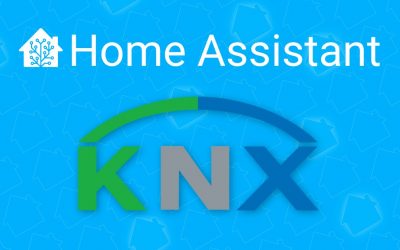
Home Assistant Core 2023.4! 🎉
The spring (release) is here! And do we have some fine new features for you
to play with this upcoming easter weekend! 🐰
I’m thrilled to see more of those new entity dialogs coming in this release.
They look beautiful and work exceptionally well from the mobile app. There is
even an added bonus of new Tile card features! But…
Oh boy, do I love the new ability to make your own Jinja2 template macros in
this release. It is mind-blowing! The best thing about them, it makes them
easily shareable as well! Can’t wait to see what you all come up with!
Happy Easter! 🐣 and enjoy the release!
../Frenck
Don’t forget to join our release party live stream on YouTube
5 April 2023, at 12:00 PDT / 21:00 CEST!
New dialogs for alarm, cover, and fan entities
The previous release
brought in new entity dialogs for lights, switches, and sirens; it seems
many of you really liked it!
So, this release @piitaya kept on trucking, implementing the designs
by @matthiasdebaat, bringing the same new clean and neat UI in entity dialogs
for alarm control panels, covers, and fans!
Covers
First up, covers! For covers, there are many variants, doors, windows, curtains,
blinds, shutters, etc. Not just that, some can be controlled by how far they
are open/closed, and others can only be opened and closed.
This is no problem for the new dialogs. They will adjust to the capabilities
your cover has:
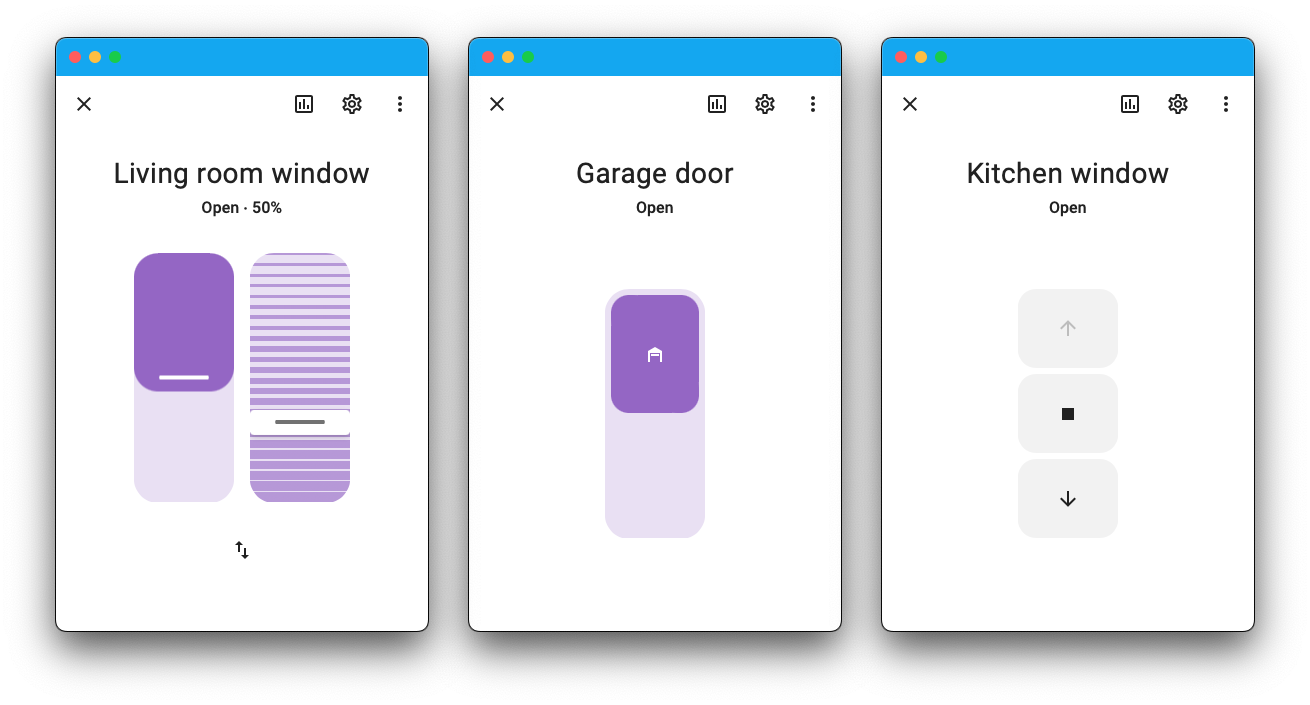
The one on the left is interesting, as the first slider controls how far down
the blinds are. Notice how it slides in from the top! The slider directly next
to it controls the tilt. Nice!
Fans
Next up, the fan entities. The UI experience shown in the dialog will
automatically adjust to the capabilities of the fan you are controlling, just
like with covers.
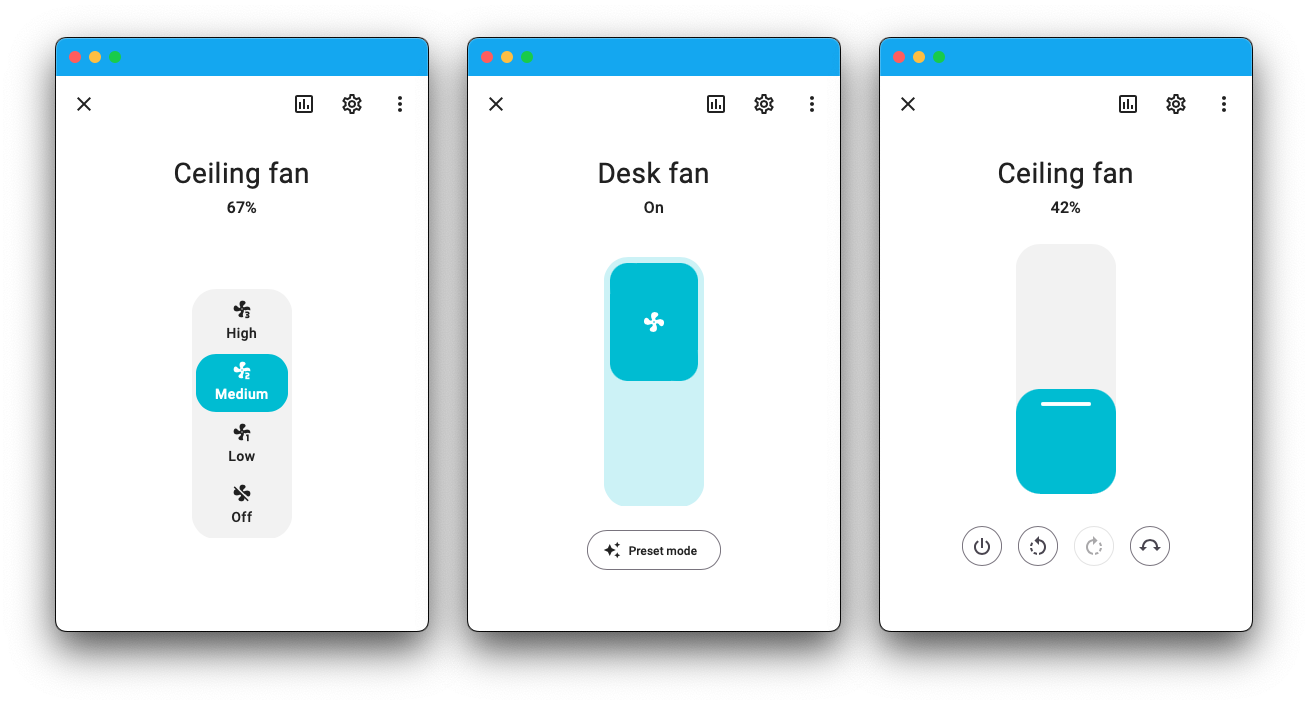
Depending on the number of speed steps your fan has, the dialog will
automatically adjust the UI. In case it has four speed steps or less, it will
show the speed buttons as on the left screenshot. Otherwise, it will use the
slider shown on the most right screenshot.
Alarm control panels
Lastly, the alarm control panel entities. They are a bit different compared
to others as, more often, these require one to input a code to arm or disarm
the alarm.
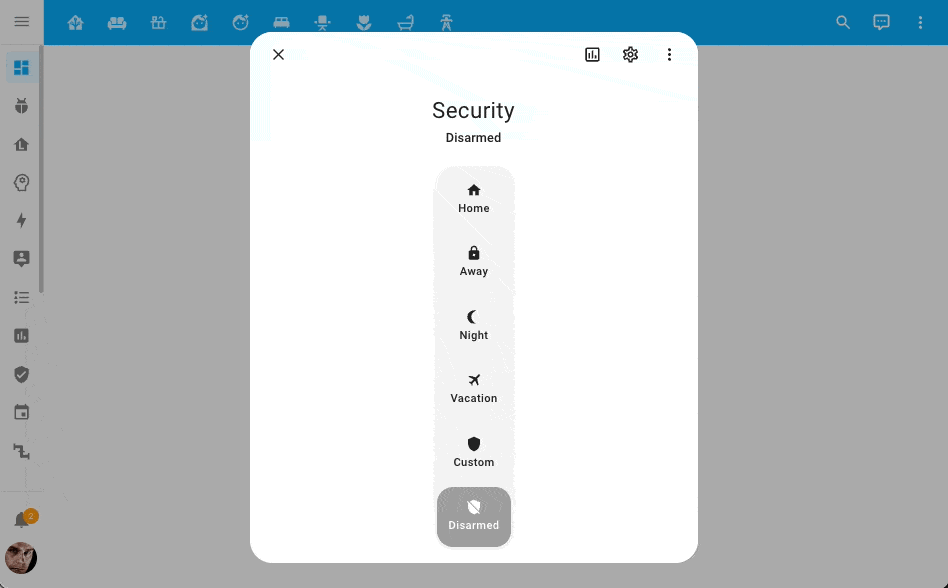
This is how arming and disarming an alarm now looks like.
When needed, the pin-pad will pop up! A nice finishing touch is the neat little
animation is shown during the process of arming and disarming the alarm.
New features for the Tile card
The Tile card has two new features: Fan speed & Alarm mode.
Both look and feel similar to the new entity dialogs from above, making the look
and feel, nice and consistent. Take a look; aren’t they beautiful?
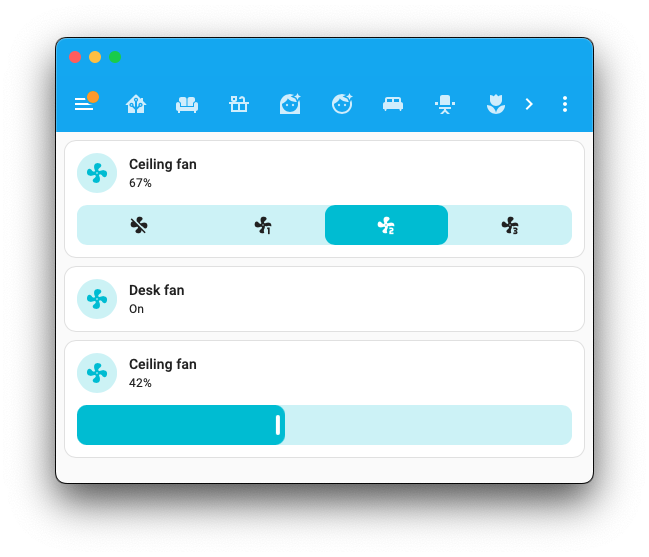
Like the new fan entity dialog, the fan speed feature will show buttons if there
are 4 speeds or less; in all other cases, it will use the slider. If the fan
can only be turned on/off, like the fan in the middle in the above screenshot,
the regular tile can be used.
The alarm mode feature allows quickly setting your alarm in a different state.
The feature provides the option to select which modes are shown as buttons in
the card.
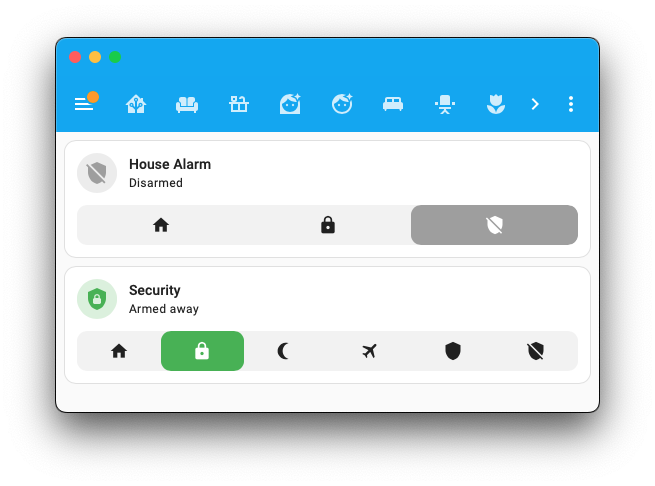
Just like with the new entity dialog, the pin pad will pop up once a code entry
is needed and even the nice little animation is there. 🤩
Macros for your templates
If you are an advanced Home Assistant user, you most likely will be familiar
with Home Assistant’s templating language: Jinja2. It allows you to do amazing
powerful things in your templates. However, if you have lots of them, you
often end up repeating similar logic everywhere!
@depoll to the rescue! He found a way to add the ability to centrally define
your own Jinja2 macros and import and use them anywhere in Home Assistant! 🤯
To support this, Home Assistant now has a new custom_templates folder, where
you can store your macros. For example, assume this file
/config/custom_templates/tools.jinja:
% macro answer_question(entity_id) %
Is the state_attr(entity_id, 'friendly_name') on?
iif('Yes', 'No') !
% endmacro %
This macro answer_question will ask and answer a question based on a given
entity ID. You can now import and use this macro anywhere in Home Assistant.
For example:
% from 'tools.jinja' import answer_question %
answer_question('light.kitchen')
Which will output:
Is the kitchen light on?
Yes!
An fantastic contribution! Thank you, @depoll!
Reusing templates documentation
More new templating features
As if the reusability of your macros wasn’t good enough already, there
is much more templating goodness in this release!
Thanks, @depoll, @ehendrix23, @petro31, and @rokam, for these amazing
additions down below! ❤️
Adjusted behavior of relative_time and today_at
@Petro31 adjust the behavior for template entities using the relative_time
and today_at template functions to update their state once a minute. Nice!
New is_hidden_entity function
The brand new is_hidden_entity function was added by @depoll, which can tell
if a given entity has been marked “hidden” or not. This function also works
as a test. Cool!
This example returns a list of all entities in the kitchen area that are not
hidden.
reject('is_hidden_entity')
New areas function
Talking about areas, @rokam added an areas function, which returns a list
of all areas you have!
A simplistic example:
Added break and continue for use in for loops
@depoll added support for break and continue in for loops, which allows
short-circuiting those loops, allowing you to make them more efficient.
%- for value in range(10) %
%- if value == 1 -%
%- continue -%
%- elif value == 3 -%
%- break -%
%- endif -%
value
%- endfor -%
New has_value function
Lastly, @ehendrix23 added a requested template function from the Month of
“What the Heck?!”: has_value. The has_value function can also be used as
test and can filter out entities currently in an unavailable or unknown
state.
You could use this conditionally, like so:
% if has_value('sensor.train_departure_time') %
The train leaves at states('sensor.train_departure_time')
% endif %
Or, maybe list all entities from the living room that currently have no state
value:
reject('has_value')
Database scalability
As your smart home grows and you add more devices, this means more data to keep
track of. This release includes significant advancements to the recorder
database design to help Home Assistant scale.
This version has a new database format that reduces the space needed to store
history for your devices. This change comes with a few benefits:
- Smaller (deduplication), less disk usage
- Reduced disk IO (SD-card lifetime improvements)
- Reduced CPU-usage 📉
- Quicker startup 🏎️
- Faster history graphs and logbook
- Reduced latency in the entire system which means less waiting from the time
you hit a button until an action completes 🚀 - Home Assistant now keeps history when renaming entities 🤘
If you are accessing the database directly, check out the Data Science Portal
and the SQL Integration for updated example queries.
It may take a while to complete background data migration, depending on the size
of your stored data. To ensure Home Assistant keeps history when renaming an
entity, wait 24 hours after upgrading before renaming.
New selector capabilities
Selectors are user inputs for the user interface
that drive things like Blueprints. A new selector for use
in Blueprints has been added by @emontnemery and @piitaya: The constant selector.
The constant selector provides an optional input, which returns a fixed value
(the constant) when enabled, otherwise doesn’t provide any value at all.
Example use in a Blueprint:
example:
name: Constant selector example
selector:
constant:
label: Enabled
value: true
Which results in the following:

When checked, the selector returns the set value.
Also improved are the device and entity filters on the Area,
Entity, Device, and Target selectors. Previously, you could filter with a
single set of conditions; now, you can pass in a list of filters.
If you are building Blueprints, this can be really helpful if a user should
be able to select one of multiple different devices.
An example, this selector allows you to select the battery sensor of
either a Philips Hue RWL020 (US) or RWL021 (EU) remote in your Blueprint.
device:
filter:
- integration: deconz
manufacturer: Philips
model: RWL020
- integration: deconz
manufacturer: Philips
model: RWL021
entity:
- domain: sensor
device_class: battery
Translating entities
Over the past releases, we’ve been slowly extending translation support in more
places in Home Assistant. This release completes support for translating
entities!
This includes the entities’ names, their attributes, and translations of
the attribute values. These translations will be visible on your dashboards,
dialogs, automation editors, etc. Pretty much all places displaying them.
Integrations have to explicitly add support for these. Quite a few integrations
have done so in this release, but we expect many to follow in the upcoming
releases.
Other noteworthy changes
There are much more easter bunnies in this release; here are some of the other
noteworthy changes this release:
- @ArturoGuerra added support for locks to Matter! Nice!
- The new light entity dialog (introduced last release) now better supports
white mode. Thanks, @piitaya! -
@emontnemery added energy storage and volume storage device classes; these
will allow differentiating between, for example, consumed energy versus stored
energy in a battery. -
@starkillerOG is rocking the Reolink integration. It now provides button,
switch, siren, select, number, and light entities for all kinds of things you
Reolink cameras and doorbells can do. Awesome! - The Universal Media Player now supports browsing media! Thanks, @Drafteed!
- The Supervisor integration now provides sensors containing the
Home Assistant Core and Supervisor’s stats. Thanks, @ludeeus! - The Spotify integration now supports podcasts! Nice @BTMorton!
-
LIVISI Smart Home now supports climate devices, switches (PSSO, ISS,
and ISS2), and window sensors (WDS). Thanks @StefanIacobLivisi & @planbnet! - ESPHome now supports pairing Bluetooth devices. Nice work @bdraco & @jagheterfredrik!
-
@MarkGodwin extended the TP-Link Omada integration to support update
entities; awesome! - All
sun.sunentity attributes are now also available as sensors, much
easier to use, thanks @gjohansson-ST! - Covers with the door device class, now appear as actual doors in HomeKit,
nice @Dexwell! -
@loongyh did something similar for Google Assistant. Covers with the
window device class now show up as actual windows. Thanks! - The SQL integration now supports settings device and state classes, thanks @gjohansson-ST!
- @teharris1 added support for the new Insteon i3 device, cool!
New Integrations
This release has no new integrations, but does provide a couple of new virtual
integrations. Virtual integrations are stubs handled by other (existing)
integrations to help with findability. These are new:
Integrations now available to set up from the UI
The following integrations are now available via the Home Assistant UI:
Need help? Join the community!
Home Assistant has a great community of users who are all more than willing
to help each other out. So, join us!
Our very active Discord chat server is an excellent place to be
at, and don’t forget to join our amazing forums.
Found a bug or issue? Please report it in our issue tracker,
to get it fixed! Or, check our help page for guidance for more
places you can go.
Are you more into email? Sign-up for our Building the Open Home Newsletter
to get the latest news about features, things happening in our community and
other news about building an Open Home; straight into your inbox.
Breaking Changes
The previously deprecated YAML configuration of the Aladdin Connect integration
has been removed.
Aladdin Connect is now configured via the UI, any existing YAML configuration
has been imported in previous releases and can now be safely removed from
your YAML configuration files.
(@epenet – #88694) (documentation)
The binary sensor providing available firmware updates has been deprecated
since 2022.5 and is now removed. Use the new update entity instead.
(@mib1185 – #89940) (documentation)
This change only affects Home Assistant instances running directly on
MacOS (not inside a virtual machine).
Any integration or device previously set up using a UUID Bluetooth
address will need to be deleted and recreated.
(@bdraco – #89926) (documentation)
The calendar.create_event service now enforces that start and end dates are
exclusive. This has always been part of the specification but was not clearly
documented and enforced.
(@allenporter – #89533) (documentation)
The previously deprecated YAML configuration of the DSMR Reader integration
has been removed.
DSMR Reader is now configured via the UI, any existing YAML configuration
has been imported in previous releases and can now be safely removed from
your YAML configuration files.
(@frenck – #89239) (documentation)
AQI sensor state values are now in English, and the user interface will
display their translation for the selected language. If you have been using
this sensor in your automations and scripts, you’ll need to adjust these for
this change.
(@bieniu – #89044) (documentation)
The name and station sensor state attributes have been removed because
they are static data that do not describe the state of the entity.
The index sensor state attribute has been migrated to a separate entity,
for example, sensor.home_no2_index.
(@bieniu – #89389) (documentation)
The behavior of passing parameters to service calls targeting notification
groups has changed.
Current behavior: data mappings configured in the service override
mappings configured in the action.
New behavior: data mappings configured in the action override
mappings configured in the service.
(@arychj – #90253) (documentation)
Not really a breaking change, but as of now, only program entities are
created for the programs your device supports. You might need to manually remove
old/existing entities that are no longer provided.
(@stickpin – #88801) (documentation)
The previously deprecated YAML configuration of the IMAP integration
has been removed.
IMAP is now configured via the UI, any existing YAML configuration
has been imported in previous releases and can now be safely removed from
your YAML configuration files.
(@jbouwh – #89981) (documentation)
The conversion to MWh and the corresponding MWh-entities have been removed.
To resolve the breaking change :
- If you make use of any of
sensor.heat_meter_heat_usageor
sensor.heat_meter_heat_previous_yearfor automations, scripts, etc.,
you can replace these with the GJ-entitiessensor.heat_meter_heat_usage_gj
andsensor.heat_meter_heat_previous_year_gj. - If applicable, in the energy dashboard, replace
sensor.heat_meter_heat_usage
withsensor.heat_meter_heat_usage_gj. Note that the energy dashboard will
still convert to MWh or kWh, therefore resulting in the same values as before.
(@vpathuis – #89522) (documentation)
Logbook will be unavailable until the database schema migration completes.
Logbook script and automation traces from previous runs of Home Assistant
will be unavailable until background data migration is completed following
the schema migration.
(@bdraco – #88942 #89465) (documentation)
Automation and script traces that include state change events recorded with
Home Assistant 2022.5.x or older will no longer display context information
for these events in the logbook tab.
(@bdraco – #89945) (documentation)
- The MySensors notify platform has been removed. It’s been deprecated since
2023.2.0. It’s been replaced by a text entity platform. - You should update any automations or scripts that use the
notify.mysensors*
service to instead use thetext.set_valueservice and the corresponding
text entity as a target. - The MySensors IR
switchentity, corresponding to anS_IRchild with
V_SENDvalue, has been removed. This entity hasb been deprecated since
2023.2.0. It’s been replaced by aremoteentity. - You should update any automations or scripts that use the
mysensors.send_ir_code
service to instead use theremote.send_commandservice and the corresponding
remoteentity as a target. Similar changes should be made for actions using
theswitch.turn_onandswitch_turn_offservices targeting the removed
IRswitchentities. Replace these withremote.turn_onandremote.turn_off
services andremoteentity targets.
(@MartinHjelmare – #90402 #90403) (documentation)
The previously deprecated YAML configuration of the Moon integration
has been removed.
Moon is now configured via the UI, any existing YAML configuration
has been imported in previous releases and can now be safely removed from
your YAML configuration files.
(@frenck – #89161) (documentation)
The tls_version configuration parameter (deprecated June 2020) has been
removed. All other MQTT broker settings have been moved to the UI before.
When the tls_version setting is still in your YAML configuration, MQTT will
not start up.
The previously deprecated MQTT broker YAML configuration has been removed.
The MQTT broker is now configured via the UI, any existing MQTT broker YAML
configuration has been imported in previous releases and can now be safely
removed from your YAML configuration files.
(@jbouwh – #87987) (documentation)
The option to define your own scan interval has been removed, data is now
updated every 60 seconds.
(@mib1185 – #89396) (documentation)
Your previously selected model has been reset to the new
and cheaper GPT 3.5 model.
(@balloob – #90423) (documentation)
The built-in areas variable is no longer overwritten and is now the same as
areas in every template. The new default template is now:
This smart home is controlled by Home Assistant.
An overview of the areas and the devices in this smart home:
%- for area in areas() %
%- set area_info = namespace(printed=false) %
%- for device in area_devices(area) -%
%- if not device_attr(device, "disabled_by") and not device_attr(device, "entry_type") and device_attr(device, "name") %
%- if not area_info.printed %
area_name(area) :
%- set area_info.printed = true %
%- endif %
- device_attr(device, "name") string) % ( device_attr(device, "model") )% endif %
%- endif %
%- endfor %
%- endfor %
Answer the user's questions about the world truthfully.
If the user wants to control a device, reject the request and suggest using the Home Assistant app.
(@balloob – #90481) (documentation)
The open and close commands for the io:CyclicGarageOpenerIOComponent device
Have been removed, see this issue
for more details on this device.
To sum up, this device is a garage door but cannot be exposed as such within
Home Assistant. There is no state returned and no clear open and close command.
Only one command is available: cycle. A button is a perfect fit for this
use case and remove all confusion; this button entity has been added this
release.
(@tetienne – #89043) (documentation)
The previously deprecated YAML configuration of the Pushbullet integration
has been removed.
Pushbullet is now configured via the UI, any existing YAML configuration
has been imported in previous releases and can now be safely removed from
your YAML configuration files.
(@gjohansson-ST – #90285) (documentation)
The previously deprecated YAML configuration of the Radio Thermostat integration
has been removed.
Radio Thermostat is now configured via the UI, any existing YAML configuration
has been imported in previous releases and can now be safely removed from
your YAML configuration files.
(@gjohansson-ST – #90284) (documentation)
Oversized events with data larger than 32KiB are no longer recorded
to avoid overloading the database and polluting the memory cache.
(@bdraco – #90747) (documentation)
The previously deprecated YAML configuration of the Scrape integration
has been removed.
Scrape is now configured via the UI, any existing YAML configuration
has been imported in previous releases and can now be safely removed from
your YAML configuration files.
(@gjohansson-ST – #90272) (documentation)
The previously deprecated YAML configuration of the Season integration
has been removed.
Season is now configured via the UI, any existing YAML configuration
has been imported in previous releases and can now be safely removed from
your YAML configuration files.
(@frenck – #89166) (documentation)
Tasmota sensor no longer sets the force_update flag to True.
Tasmota binary_sensor no longer sets the force_update flag to True, except
for binary_sensor mapped to a Tasmota switch with switchmode set to 13 or 14.
(@DerEnderKeks – #85943) (documentation)
The relative_time and today_at template functions and filters are no
longer supported in limited templates.
(@Petro31 – #86815)
Enumerating states using templates are no longer sorted by
entity_id by default, as it was computationally expensive.
To restore the original behavior, a sort filter can be added to any
existing template using the below example:
% for state in states
The behavior of the threshold binary sensor has changed:
- The threshold binary sensor’s state is reset to
unknownwhen the monitored
sensor’s state is unknown, unavailable, or not a valid float. - When the monitored sensor’s state is first valid, or when it’s valid
after beingunknown,unavailable, or not a valid float:- Initialize a threshold sensor with only a lower threshold to state
off,
with thepositionattribute set toabove. - Initialize a threshold sensor with only a upperthreshold to state
off,
with thepositionattribute set tobelow. - Initialize a threshold sensor with only an upper and a lower threshold
to stateon, with thepositionattribute set toin_range.
- Initialize a threshold sensor with only a lower threshold to state
(@emontnemery – #88978) (documentation)
The end-date for garbage collection events on the calendar entity, will now
be one day later compared to the start date. This is because in calendaring,
the end-date is exclusive.
(@bobvandevijver – #89028) (documentation)
The previously deprecated YAML configuration of the Volvo On Call integration
has been removed.
Volvo On Call is now configured via the UI, any existing YAML configuration
has been imported in previous releases and can now be safely removed from
your YAML configuration files.
(@gjohansson-ST – #90288) (documentation)
With this release, you will need to update your zwave-js-server instance.
You must use zwave-js-server 1.27.0 or greater (schema 27).
- If you use the
Z-Wave JSadd-on, you need at least version0.1.77. - If you use the
Z-Wave JS UIadd-on, you need at least version1.8.1. - If you use the
Z-Wave JS UIDocker container, you need at least version8.11.1. - If you run your own Docker container or some other installation method, you
will need to update yourzwave-js-serverinstance to at least1.27.0.
(@raman325 – #90212) (documentation)
If you are a custom integration developer and want to learn about breaking
changes and new features available for your integration: Be sure to follow our
developer blog. The following are the most notable for this release:
Farewell to the following
The following integrations are also no longer available as of this release:
-
Dark Sky has been removed. Apple acquired Dark Sky, and the API has now
been shut down. (@gjohansson-ST – #90322) -
Magicseaweed has been removed. Magicseedweed no longer provides API keys
to users. Additionally, the integration is no longer in a functional state.
(@gjohansson-ST – #90277)
All changes
Of course, there is a lot more in this release. You can find a list of
all changes made here: Full changelog for Home Assistant Core 2023.4
Kontakt oss for elektrikertjenester i Agder!
Som elektrikerbedrift i Agder leverer Elektriker Kristiansand elektrikertjenester i Kristiansand, Søgne, Mandal, Lillesand, Grimstad, og Arendal. Små og store oppdrag er ikke noe problem for oss. Et nytt sikringsskap, reparasjon av elektriske systemer, smarthussystemer som sparer energi og mer er alt tilgjengelig for deg fra oss. For gode elektrikere, kontakt oss.


